Stem
Stem - a vegetative above-ground organ of a plant, having a radial structure, apical growth in length.
stem functions the following:
- the place of formation of leaves and flowers, and in their axils - axillary buds; assimilation of organic substances; transport of water, mineral and organic substances from the root to the leaves and back; storage of nutrients and water; vegetative reproduction. in some plants, the stems perform the functions of leaves (for example, in cacti, performing an assimilation function) and protecting plants (thorns and thorns develop).
The stem is part escape.
The escape - a stem with leaves located on it, grown in one growing season, as a rule, unbranched. It can be considered as a single organ of the same rank as the root (the root is an underground organ, the shoot is aboveground, both are derivatives of the apical meristems). However, unlike the root, the shoot has a complex structure and is divided into specialized parts:
- axial organ - stem lateral organ - leaf modified shoots - buds that provide growth, branching and the formation of a shoot system.
The shoot consists of nodes and internodes. knot It is customary to call the section of the stem where the leaf and bud are located. internode - the section of the stem between adjacent nodes. According to the degree of development of internodes, shortened and elongated shoots are distinguished. The peculiarity of the structure of the stem is manifested in the alternation of nodes and internodes. Therefore, the leaves on the stem can be located in the next, opposite or whorled order.
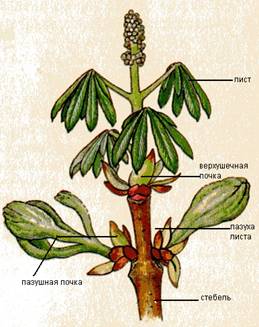
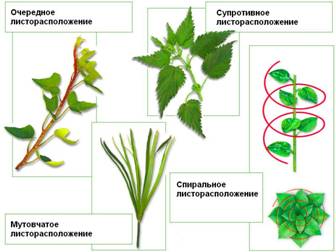
Depending on the functions performed, the shoots are vegetative (the function of air nutrition) and generative (the flower is the function of reproduction).
font-size:14.0pt;color:teal"> Kidney
is a shortened rudimentary shoot, which is in a state of relative dormancy, with rudimentary leaves and flowers. From above, the kidney is usually covered with scales. At the top of the stem is the apical bud, it contains a section of the stem called the growth cone, which consists of meristematic cells; at a favorable time of the year, these cells divide intensively. In the axils of the leaves are lateral axillary buds, from which lateral shoots develop. In flower buds, embryonic flowers or whole inflorescences are laid.the existence of plants, the so-called wintering (or resting) buds, dormant buds, adventitious buds (for example, on stumps) are formed.
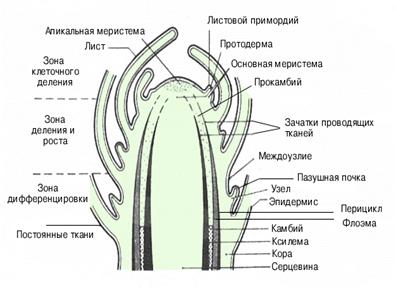 The stem, like the root, develops from the germ of the seed. In most plants, the direction of stem growth is vertical (woody, herbaceous plants). The stem, in contrast to the root, has negative geotropism (or positive heliotropism), that is, it grows from the center of the earth to. The growth of the stem in length occurs due to cell division of the apical meristem in the growth cone, which is located in the apical bud. The diagram shows the formation of permanent stem tissues from meristem cells.
The stem, like the root, develops from the germ of the seed. In most plants, the direction of stem growth is vertical (woody, herbaceous plants). The stem, in contrast to the root, has negative geotropism (or positive heliotropism), that is, it grows from the center of the earth to. The growth of the stem in length occurs due to cell division of the apical meristem in the growth cone, which is located in the apical bud. The diagram shows the formation of permanent stem tissues from meristem cells.
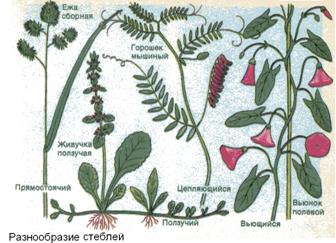
Under various environmental conditions, erect, ascending, recumbent (creeping), creeping (whips and whiskers), climbing and climbing stems develop.
Most plants have side stems in addition to the main stem. Branching (development of lateral shoots) has its own patterns. Lateral shoots develop in different directions, due to which the crown of plants is formed.
There are dichotomous, monopodial, sympodial and false dichotomous branching. With dichotomous branching, the apical point of growth is divided into two, which give branches of almost the same size, the main axis is not expressed. With monopod branching, the main stem grows at the expense of the apical bud throughout the life of the plant. Sympodial branching is characterized by the fact that the apical bud of the main and side shoots freezes after some time, its growth cone
stops functioning or stuns and then withers away. Then growth continues from the axillary bud closest to the apex. The growth of the branch goes towards the main
axes. False dichotomous branching is observed in trees and shrubs with opposite leaves. After the top of the annual shoot dies off, not one replacement shoot grows, but two.
The structure of the stem changes during ontogeny, but, nevertheless, some basic features should be considered. anatomical structure of the stem dicots (woody and herbaceous) and monocots.
On a cross section dicotyledonous plant three concentric zones are distinguished: the outer cortex, the vascular bundles or the central cylinder and the core, consisting of colorless parenchymal cells, where nutrients are stored.
In herbaceous plants the outer layer of stem cells is the epidermis, the cells of which are thickened and contain cutin. Beneath it lies a layer of thick-walled collenchyma cells that perform a mechanical function. Next is a layer of loose thin-walled parenchyma cells and, finally, behind them are thick-walled endoderm cells adjacent to the conductive tissues.
In woody plants in young stems closer to the center are the vascular bundles. Each vascular bundle consists of an outer group of phloem cells and an inner group of xylem cells, separated by a layer of meristematic tissue - procambium. As a result of continuous mitotic activity, the procambium forms new phloem cells on the outside, and new xylem cells on the inside. Between the vascular bundles are core rays - groups of cells that stretch radially from the vascular tissue to the core and to the cortex and serve to move substances and water from the xylem and phloem to the internal and external tissues. Conductive bundles are located along the circumference of the stem in one, less often two rows, approximately at the same distance from the integumentary tissue. The conducting system is located in the form of vertical strands along the axis of the stem, which is clearly seen in the vertical section of a woody plant.
color:teal">interfascicular cambium , procambium turns into bundled cambium , so that then a continuous ring of cambium is formed both between the vascular bundles and inside them. In subsequent growing seasons, the cambium produces additional layers of secondary xylem ( wood ) and phloem ( bast ), pushing aside the primary phloem and xylem. The secondary phloem forms a thin continuous layer of nutrient-conducting tissue outside the cambium, and annual deposits of secondary xylem in woody plants form growth rings. Annual ring - this is a concentric layer of growth in the secondary xylem, formed by the cambium in one season. The basis for distinguishing annual rings is the difference in density of wood formed at the beginning and at the end of the growing season. Xylem vessels that develop in spring are wider and appear lighter than vessels that appear in autumn, so the boundaries between them are visible to the eye. The width of individual growth layers can vary greatly from year to year depending on illumination, temperature, precipitation, available soil moisture, the length of the growing season, and other environmental factors. It correlates quite well with the amount of precipitation in the corresponding year. Under favorable conditions, the rings are wide, under unfavorable conditions, they are narrow. The science of dendroclimatology is engaged in the study of annual rings. The purpose of its study is to determine the age of old trees by cuts and establish climatic conditions for a given period in the past. Thus, a picture of natural conditions was established for about 8200 years (saw cuts of spined pine trunks were used). Thanks to the work of the cambium, the woody stem grows in thickness.
In the second year, cork cambium is also activated in woody plants. It is located under the collenchyma and is formed from parenchyma cells. Thanks to its activity, a waterproof layer forms on the surface of the stem. traffic jams , and below it is a layer of living cells. Cork, layer of living cells and bast are called bark woody plant. The activity of the cambium and cork cambium persists for many years. As a result, they accumulate: a thick layer of secondary xylem, a thinner layer of bast, a layer of cork slightly increases. Primary tissues are flattened and destroyed over time.
Diffusion" href="/text/category/diffuziya/" rel="bookmark">diffusion of gas from lentils into and out of the stem. In young woody plants, an assimilating parenchyma appears under the epidermis, in the cells of which, as the plant "ages", chloroplasts gradually are destroyed, and the cells themselves are lignified and replaced by collenchymal cells that perform a mechanical function.
In a dicotyledonous herbaceous plant, stem growth in thickness can occur due to parenchyma cells (cacti store water in the parenchyma, potato tubers contain starch in the same cells).
In monocots In herbaceous plants living for one growing season, in the cross section one can see the absence of a layer of bark, the vascular bundles do not contain cambium (there is no secondary thickening of the stem) and are surrounded by mechanical tissue. Such vascular bundles are called closed. Bundles of various sizes are randomly scattered along the stem. The core is loose, quickly destroyed, forming a cavity (there is no storage of nutrients). In woody monocots (dracaena, aloe), secondary thickening can occur, which occurs in an original way. Along the periphery of the stem, a zone of meristem cells is preserved; these cells are similar to cambial cells, but work differently. Inside, they lay cells of the parenchyma and vascular bundles. The cells deposited outside form an integumentary tissue similar to a cork.
font-size: 14.0pt;color:teal"> The main function of the stem is conductive. Distinguish between near and far transport of substances.
Middle transport - this is the movement of substances between cells and tissues, for example, from the soil - to the central cylinder of the root, from the core of the stem - to peripheral tissues, from the mesophyll - to the vascular bundle. The travel distance is a few mm. Occurs along the radial phloem-xylem rays, the solution moves along the cell walls (apoplast), their cytoplasm (symplast) and vacuoles. Thanks to the short-range transport, the stem tissues are supplied with nutrients, harmful substances are deposited in the cork cells and then sloughed off.
long distance transport is the movement of substances between organs in the whole plant. The travel distance is from a few cm to tens of meters. Occurs along the conducting system: along the xylem - "upward current", along the phloem - "downward" current. In the stem, water and salts absorbed by the roots rise mainly along the tracheids and xylem vessels, while sugar and other organic substances move along the sieve tubes of the phloem.
Although the transfer path water known for a long time, the mechanism of this process is still not entirely clear. In order to raise water to the very tops of trees, a certain pressure is necessary (according to some estimates, in tall trees this pressure can reach 30 atm.). Such pressure could be created at the base of the plant and push water up, or it could be at the top of the plant and pull water from the roots. Most likely, the pressure develops due to the combined action of these forces.
The rise of water along the xylem occurs, apparently, due to the evaporation of water in the leaves. In the process of evaporation, a lack of water is formed in the crown. The surface tension in the xylem vessels is capable of pulling up the entire water column, creating a mass flow. The rate of water rise is about 1 m/h (up to 8 m/h in tall trees); to raise water to the top of a tall tree, a pressure of the order of 40 atm is required. It should be borne in mind that only capillary effects can raise water to a height of no more than 3 m. The water column in the xylem vessels experiences suction pressure from above (due to water transpiration by leaves) and is in an extended state. However, between water molecules connected to each other by hydrogen bonds, there is a strong mutual adhesion and therefore thin water strands in xylem vessels exhibit greater tensile strength. Due to the tension and adhesion of water molecules created as a result of transpiration, the water column rises along the xylem, which has few partitions (like a water pipe). In addition, the leaves have a high concentration of organic substances, and they, in turn, seem to “suck up” water. Since the concentration of organic substances in the root cells is lower than in the leaves, a difference is created between the osmotic pressure of the juice in the leaves and the root (often this difference
defined as the sucking power of the plant).
Nutrients move along the sieve tubes of the phloem. Unlike xylem, organic matter can be transported up and down the phloem. 90% of the transported substances are sucrose, which practically does not participate directly in the metabolism of the plant and is therefore an ideal carbohydrate for transport. The speed of movement of sugar is usually 20-100 cm / h; in a day, several kilograms of sugar (in dry mass) can pass through the trunk of a large tree.
How such large flows of nutrients can flow in thin phloem sieve tubes (their diameter does not exceed 30 microns) is not entirely clear. The substances carried by the phloem pass through living active cells, in contrast to the xylem, in which water and sap rise through empty tubes from dead cell walls without cytoplasm. Phloem sieve tubes contain cytoplasm, the ends of their cells are connected to each other by cytoplasmic filaments passing through small pores in sieve plates (modified cell walls). It is assumed that, on the one hand, substances that have passed through the sieve plate are picked up by the cytoplasmic current, which is directed upwards on one side of the cell and downwards on the other, and can
|
Sieve tube in section. |
move from one cell to another; on the other hand, water with substances dissolved in it moves through the phloem tubes under pressure "down" along the gradient of turgor or osmotic pressure. Most likely, the transfer of substances through the vessels of the phloem is not carried out according to one law, but there are several mechanisms for the transfer of substances at the same time. , for example, substances spread through the phloem by mass current, diffusion. Possible transport mechanisms are conventional pressure or electroosmosis.
If the phloem is damaged, the sieve tubes become clogged as a result of the deposition of callose on the sieve plates. Irreversible nutrient leakage usually stops within minutes of injury.
Metamorphoses (modifications) of the stem - tubers, bulbs, rhizomes - contribute to the survival of adverse conditions by plants (drought, winter, etc.). They store nutrients for later development.
tubers are strongly thickened fleshy underground or above-ground shoots. Underground tubers (potato, Jerusalem artichoke) develop on stolons. On the surface of the potato tuber there are eyes - places of attachment of underdeveloped leaves, in the axils of which there are kidneys. Above-ground tubers develop in kohlrabi cabbage, some types of orchids.
http://pandia.ru/text/79/409/images/image012_17.jpg" align="left" width="324" height="240 src=">
Bulb - shortened underground escape. Its stem is underdeveloped, has a disc-shaped shape and is called a donets, from which adventitious roots and numerous,
closely spaced leaves (bulbous scales) in which reserve nutrients (onions, garlic, lilies) are deposited. At the top of the bottom, in the axils of the bulbous scales, there are buds from which above-ground shoots and new bulbs are formed.
color:teal"> The corm resembles an onion in shape, but reserve nutrients are deposited here in the stem part, while the scales are dry (gladiolus, saffron, colchicum, etc.).
color:teal">Rhizome is a modified underground shoot bearing scaly leaves and buds with
adventitious roots. Spare nutrients are deposited in the stem part of the shoot. The rhizome looks like a root, but differs in the presence of leaves; the rhizome ends with a kidney, and not with a root cap (lily of the valley, creeping couch grass, valerian, etc.).
Sometimes shortened shoots are formed, modified into spines , which protect plants from being eaten by animals, they develop from lateral buds in the leaf axils
In pumpkin, cucumber, melon, grapes, part of the shoots is modified into antennae .
cacti fleshy stems play the role of not only original water reservoirs, but also assimilation organs.
In some plants, the stems take the form leaf blade (phyllocladium), are green and perform the function of photosynthesis (for example, in the needle).

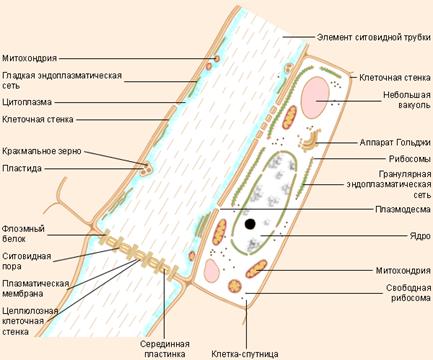 10
10